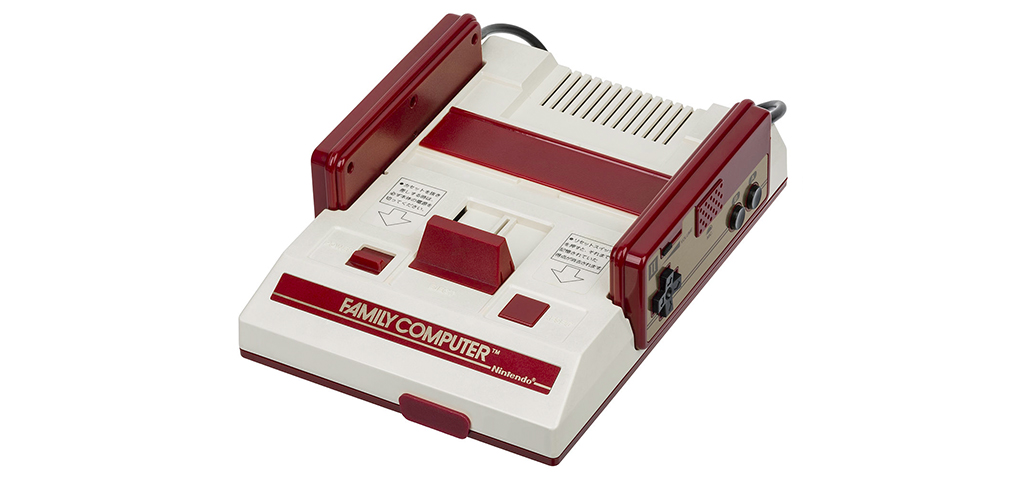Before the NES was the Nintendo Famicom. The most important console of all time, Nintendo’s video game console par excellence, an 8-Bit machine that took over and revolutionized the video game market, subsequently conquering the entire globe thanks to the quality of its video games.
Let’s get to know the original console, the machine that was everything in the land of the rising sun and the development of the video game industry: The Nintendo Family Computer, the first third generation console, the console that redefined video games, culture and society throughout Japan and its subsequent generations.
| COMPANY: | Nintendo |
| GENERATION OF CONSOLES: | 3rd GENERATION OF CONSOLES |
| RELEASE DATE: | 1983 Japan |
| GAMES CATALOG: | 1,053 Japanese cartridges // 198 commercial discs plus 4 official not for sale (FDS) |
| SOLD UNITS: | 19 million in Japan |
| LAUNCH PRICE: | 14,800 yen |
| PROCESSOR: | Ricoh 8-bit based on MOS Technology 6502 at 1.79 MHz |
| FORMAT: | Cartridge and magnetic disk (Famicom Disk System) |
| BUY IT ON EBAY: | https://ebay.us/fs0YR9 |
- History of the Nintendo Famicom.
- Famicom Disk System.
- Famicom models and versions.
- Price of a Japanese Famicom console. How much?
- Collect the original Famicom.
- Buy a Japanese Famicom.
- TOP Retro: Best Famicom Games.
- Nintendo Famicom FAQ.
- Technical characteristics of the original Famicom.
Family Computer, the original Famicom
Released on July 15, 1983 in Japan for 14,800 yen, the Famicom is the Japanese 8-bit console that saved the industry and revolutionized the video game market, especially the console, video game machines that had gone from a growth absolute in the 1970s to being on the tightrope at the beginning of the 1980s, with the microcomputer sector treading all the ground. With the Famicom, Nintendo created a masterpiece that conquered the world from Japan, a super console for its time that would lead the way for all others.
Antecedentes de la Famicom y contexto
The history of Nintendo goes back to 1889 in Kyoto, Japan but in this case we are not going to go that far back… After a century dedicated to cards and later to toys, Nintendo is introduced by the hand of its president, Mr. Hiroshi Yamauchi and master Gunpei Yokoi in the electronic entertainment industry to later make the leap to video games:
- 1973 Nintendo achieved an ephemeral but resounding commercial success with its Laser Clay Shooting System, virtual shooting galleries (projections) that were installed in bowling alleys throughout Japan, unseating bowling for a time as the Japanese favorite leisure activity.
- 1974 Continuing with the technology of projection, Nintendo launches its smaller arcade games for a single player in which it combined the technology of rifles/light guns and 16mm projections, the Simulation System. Some examples of these arcades are: Wild Gunman, New Shooting Trainer, Skyhawk and Battle Shark.
- 1975 Together with Mitsubishi Electric, they launch the EVR System arcade machines, machines that were based on Electronic Video Recorder technology, through which for the first time in Nintendo’s electromechanical arcade games, the image did not come from a projector but from an audiovisual format, the EVR , reproduced on a screen. The arcades that made use of the EVR such as the EVRRACE were in practice lotteries/bets to hit the order of arrival, based on random videos stored in the EVR.
- 1977 We finally arrived at the first Nintendo home consoles, launched the same year the Color TV-Game 6 and the Color TV-Game 15 were two systems according to their time based on integrated games variations of Pong, seeking to conquer the market Japanese. Thanks to their low price strategy in relation to the competition (20,000 yen for the Epoch console) they obtained good sales results. The Color TV-Game 6 served as a claim for 9,800 yen, customers finding the Color TV-Game 15 for 15,000 yen at the time of purchase, the latter counting with many more video games.
- 1978 is a crucial year for Nintendo as it enters the arcade video game market as we know it today, with the Nintendo Computer Othello being its first arcade machine. From this moment we all know the evolution of Nintendo and video games. At the same time, Nintendo launched the Color TV-Game Racing 112, a dedicated console with a built-in steering wheel for 18,000 yen. The Color TV-Game Racing 112 actually had 112 variants of racing and Pong games, but watch out! We are talking about variants and permutations, not games as we know them.
- 1979 Nintendo released the dedicated Color TV-Game Block Breaker console, a console based on its Block Fever arcade game, which was a copy of the Atari Breakout, which many of us now know as the Arkanoid.
- 1980 This was an extremely important year for Nintendo, since in addition to the home console Computer TV Game, based on its Computer Othello and sold for 48,000 yen, Nintendo launched the new invention of master Gunpei Yokoi, the Game & Watch. With the Game & Watch, Nintendo achieved tremendous success that would last for many years, expanding and conquering the world video game market. Its starting price for the first models was 5,800 yen.
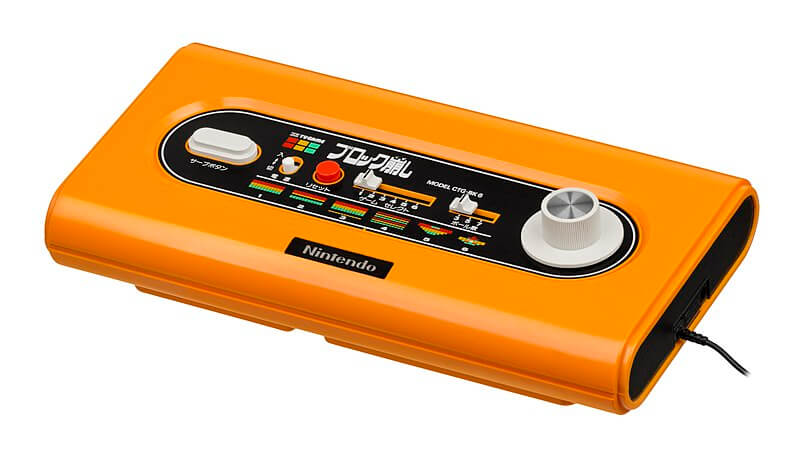
As we can see, Nintendo’s experience in the early 1980s was comparable or superior to any company in the Western video game industry. Both in the 1970s and in the early 1980s, the West, and especially the United States, were the cradle of video games, home consoles, arcade games, personal computers, a growing number of European microcomputers and software studios, belonged to a western-led industry at the time.
But if a nation knew how to absorb all that knowledge and integrate it into the roots of its culture and society, it was Japan. From importing arcade games and systems from abroad, in a few years they went on to create a true video game industry on a par with the United States. Thanks to the good commercial relations with the United States and a brazen permissiveness on the part of the Japanese administration regarding intellectual property law, in addition to a protectionism that favored its own commercial interests, an ideal breeding ground was created to adopt and promote the industry. of the video game.
Added to the industrial and technological boom that Japan was experiencing in those years, in which the middle class grew vertiginously, Japan went from importing to exporting the latest technology products such as video games, enjoying such well-known successes in the world of arcade games as Pacman , Space Invaders or Donkey Kong.
Japan became an oasis for video games unlike the West, where a series of bad practices and attacks from various lobbies such as that of toymakers, were destroying the image of video games, especially that of video game consoles, since that they only had the purpose of playing (zero educational). Microcomputers were gaining ground thanks to their versatility while consoles seemed destined for oblivion… And so came the Crash of 1983, a turning point in which the console and video game market descended into hell. But of course… we’re talking about the West.
Meanwhile in Japan, as it was already a country that produced and exported video games, the industry was seen as an economic good that generated work and wealth, enjoying a good reputation and image. Having its own market with a wide range of Japanese products, both hardware and software, the failure of Atari and its lousy games was hardly noticed within its borders, but even so, the consoles were losing ground in favor of microcomputers. At the beginning of the 80’s’. Until the Famicom came along.
Nintendo Family Computer
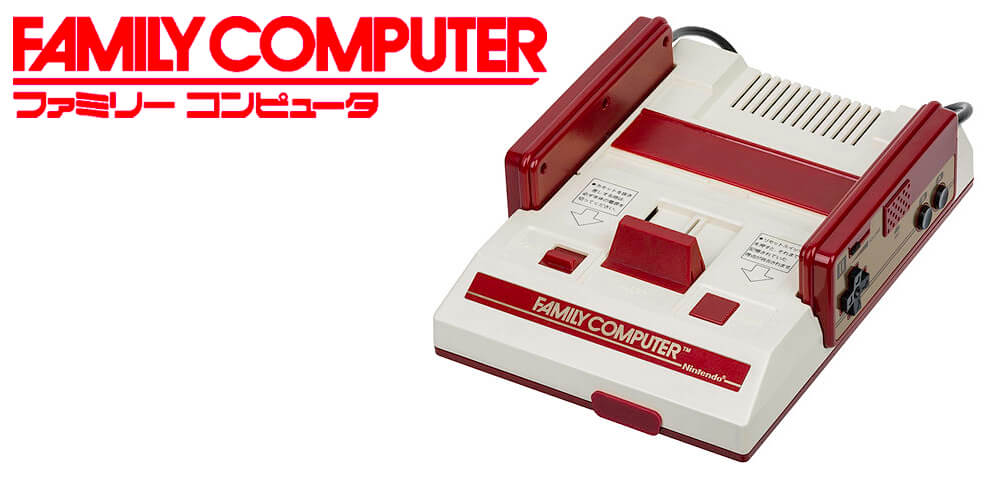
On July 15, 1983, the Nintendo Family Computer, better known as the Famicom and later exported as the NES to the rest of the world, was launched in Japan for the affordable price of 14,800 yen. The Famicom came to the Japanese market camouflaged as a system that combined the benefits of an 8-bit cartridge console with those of a microcomputer thanks to the peripherals that were to come.
In practice, the real possibilities of transforming our console into a microcomputer were nothing more than a good marketing proposal at a time when the heads of families had to justify a purchase of this type with some excuse, even if it was lying to themselves. Programming in Basic was fine, but the strong point and commercial claim of the Nintendo machine was that of having the most powerful console of the moment, capable of bringing arcade games to Japanese homes for the cheapest price in the Japanese market, both on consoles as on most microcomputers.
The Famicom was a video game console with luxurious technical features, much higher, for example, than those of its supposed direct competition, the SEGA SG-1000. It is true that the Famicom’s CPU was not especially fast, but thanks to its architecture in which it had support chips dedicated to graphics and sound independently, as well as the possibility of vitaminizing the cartridges with new components, Nintendo had managed to make an economical product with great benefits, comparable in its first years to the most successful recreational ones.
So that you can understand the technological leap that the Famicom meant, in the following YouTube video we see a comparison with the same games, between the Nintendo console launched in 1983 being the first third generation console, with the Atari 2600 from 1977 being the second generation, which was the most popular console until the consolidation of the Famicom and with which it coexisted commercially for many years (until 1990).
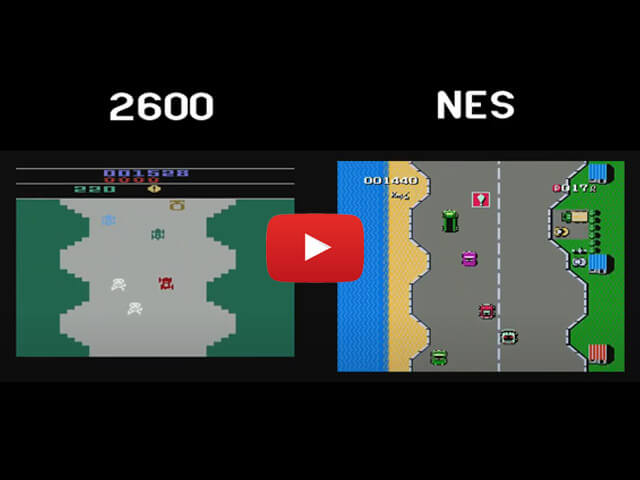
As you have seen, the gap between the two consoles and generations is abysmal, with many conversions of the Atari 2600 being a joke if we compare them with the Nintendo console. This was the visual impact that players of the time had, a world separated both consoles… It is true that in the second generation there were more powerful consoles than the Atari VCS such as Colecovisión or Intellivision, but most players had the Atari console, being the real benchmark of its entire generation.
Nintendo had created a great machine, with a business model based on selling cheap consoles and expensive cartridges, the plumber’s company based its main source of income on charging developer companies for licenses. In a few years, the Famicom had conquered Japan and dominated the video game sector, being the most popular system and in which the money was. With an absolute advantage position, Nintendo controlled video game developers with an iron hand, with contracts that prioritized quality over all other aspects, even imposing a maximum number of annual releases per company to ensure proper development and dedication in licensed video games.
These draconian measures, for the user, achieved a considerable increase in the average quality of video games, it was no longer the specialized press who filtered the different games, Nintendo’s policy and its quality seal (Nintendo Seal of Quality) with their criticism. It did a preliminary screening, evaluating which video games were ready to be released and censoring anything that smacked of sex, blood or drugs along the way. Like it more or less, the formula worked and Japan was filled with Famicom consoles in most homes.
Famicom and Nintendo set the pace for video games until the arrival of 16 bits, and despite having an infinity of peripherals of a very diverse nature, such as for connecting to the Internet, programming in Basic, singing karaoke or exercising in a mat, his catalog of video game cartridges was his greatest asset. The Famicom had enough power to develop new worlds, genres and execute ports of the best arcade games of the moment. To ensure a large quality catalog, Nintendo developed and marketed a multitude of titles from its own brand, these being a guarantee of good work and a beacon for other companies.
When the competition came with 16-bit consoles like the Mega Drive or PC Engine, Nintendo gave its cartridges new and more powerful support chips to cope with the new consoles. The message from Nintendo was simple: You don’t need a new console, with the Famicom you have everything… And if you liked Mario, you needed a Famicom yes or yes. No competing console could with the Famicom, it was Nintendo itself who launched the Super Famicom in 1990, from which time the support of the Kyoto company was poured into its new machine.
1994 was the year in which the last commercial Famicom game was launched, the Takahashi Meijin no Bōken Jima IV or Adventure Island 4 by Hudson Soft, thus coming to an end with 11 years of commercial life, a console that has been everything in the history of video games. Almost 20 million units sold in Japan, more than 60 million worldwide and a catalog (Japanese) of more than 1000 games, Famicom marked the way to follow an entire industry, consolidating the concepts that should govern a video game console. video games: Great features, affordable price and a huge catalog of quality.
The legacy of the original Famicom
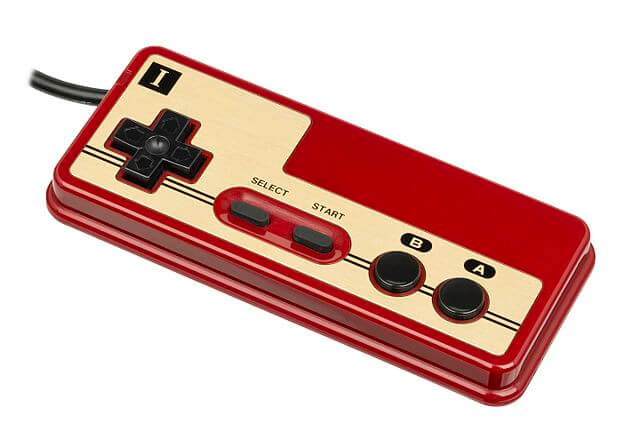
A console with such an overwhelming success as the Famicom does not simply disappear, the Famicom is still present among us in many different ways, let’s get to know the legacy of the quintessential Japanese console:
- Super Famicom: The heir to the first original Famicom faced much tougher competition and still emerged victorious. Its key to success was very similar, a powerful system thanks to its architecture, a large catalog of video games and support chips in the cartridges when necessary.
- The cartridge: Today it may seem obvious, but in the 80’s there were formats as diverse as cassettes, magnetic disks, memory cards or Compact Disks themselves. The Famicom showed that despite its price, the cartridge was a format whose advantages surpassed any other in those years, being adopted in the next generation of desktop and portable consoles.
- The controller: Before the pad there was the joystick… And I assure you that nostalgia aside, the pad is an infinitely superior controller for most video games. Its adoption in the industry is undoubtedly due to the success of the Famicom and of course to its inventor, the great Gunpei Yokoi.
- The most epic sagas: Many of the sagas that we enjoy today were invented or triumphed in the eyes of the public on the Nintendo console. Think of any saga, from Final Fantasy to MegaMan through Zelda or Bomberman… All the sagas dating back to the 80’s have passed through the Famicom.
- The seal of quality: Nintendo’s quality policy has been taken as a reference in the world of video games, being a way to protect the interests of the Japanese company and those of the users themselves. All the games that were launched on their system had to have a minimum quality and have passed a filter, only then would Nintendo allow their distribution. Something so simple, saved the video game industry in a few years in which we players did not have the immense information that circulates today about video games, buying on many occasions based on the cover with the corresponding disappointment.
- Contracts with developers: Closely tied to the seal of quality, Nintendo took a superior position in negotiations from its vantage point… If you wanted to publish a video game on the best-selling console in the world, you had to jump through hoops. In this way, the companies made an effort to launch the most elaborate games ever since they had to sell a large number of units to make the investment profitable, with a limited number of annual launches per studio to make matters worse. Licensing contracts to publish the games in Nintendo served as a reference for the rest of the companies in the following years, being generally more benevolent than those of Nintendo.
- Own studies: Nintendo understood from the first moment that it could not leave the fate of its console to external studies. The Famicom needed quality video games that made the most of its console, while serving external studios as an example of how far its machine could go. Since then, any successful console in the history of video games has been accompanied by a large assortment of video games from its own studios throughout its life.
The gaming experience, is it currently playable?

And we come to one of the most important points when talking about any retro console… How has the Famicom aged? Is it playable today? Go for it:
With a console of 11 years of commercial life, we must distinguish the video games launched in its first years with the last ones, games that are much more complete and close to 16 bits. Clarified this, we can say without fear of being wrong that Nintendo’s Famicom has aged very well, only in the case that the nostalgia factor comes into play, that is, that we have lived through that time. Hard but true.
If as a server, you were lucky enough to start with a ZX Spectrum or similar, the Famicom will continue to seem like a console worth playing and enjoying, much more in those games of your childhood or those released in recent years. But if you started your journey on later consoles and you don’t enjoy that nostalgia factor, you will be faced with games that you will perceive as having simple graphics, with developments largely based on mechanics and mostly shallow…
eye! That there are great games perfectly playable for everyone today, but they are not the general trend of a catalog of more than 1000 games started in 1983, created for users with a capacity for wonder according to their time, and as much as we despite being old as a server, there are genres that have already been overcome by natural evolution. Consequently, while it is true that there are timeless gems, we are faced with a catalog of essentially pure video games, typical of their years and lacking all those developed elements that characterize current games.
Conclusion? If you are players of the time, you will continue to appreciate the advances that were made in those great years of 8 bits and if you are younger, make sure you choose very well what to play within the console catalog, the Famicom is a console full of timeless classics that will entertain you, while also being a wonderful lesson in digital archeology and video game history.
Famicom Disk System
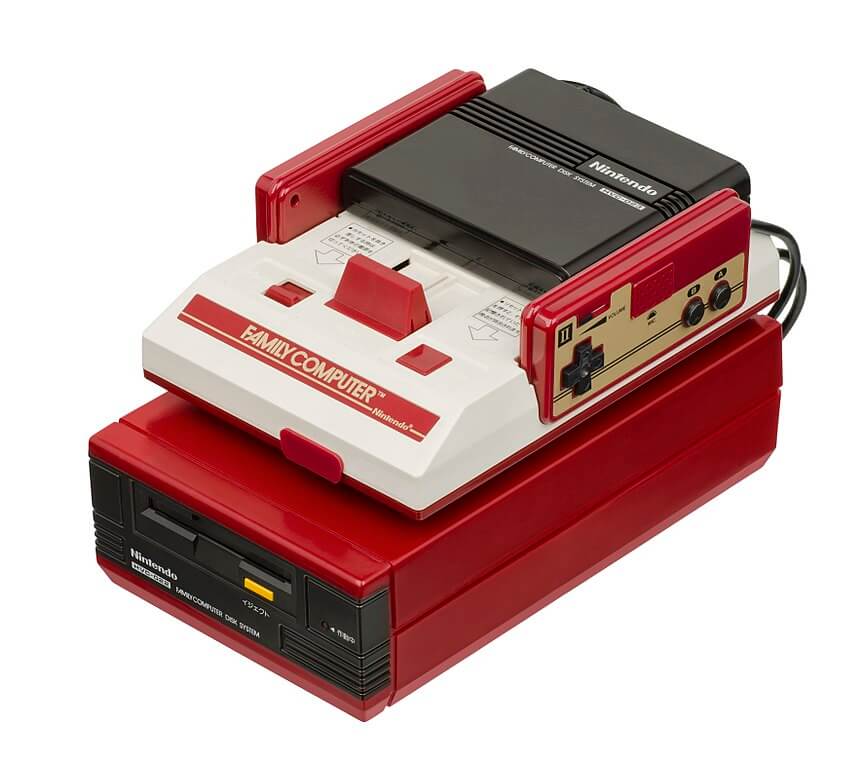
In the mid-1980s, Nintendo was observing the rise of entertainment computers in Japan, machines that offered increasingly better gaming experiences in much cheaper formats than cartridges. From about 3,000 yen in its first cartridges, the average price of the Famicom cartridges had risen to 5,000 yen within a few years, due to the high price of memory, being much higher than the price of tapes or computer disks. .
The prices of the cartridges were so expensive for the time, that the sellers themselves demanded that Nintendo lower the cost of their games, this being a common criticism from its users. On the other hand, developers were at the crossroads of needing more memory to make better games as users demanded, thus increasing the price of cartridges. Nintendo saw in this context a double threat:
- Possible flight of users to other systems with cheaper games or easier to copy.
- Drop in game quality as some developers opt for making simpler but cheaper games.
Faced with this situation, Nintendo launched the Famicom Disk System on February 21, 1986 for 15,000 yen, a rewritable disk drive for its 8-bit console, becoming one of the best peripherals of all time. Based on the formats used by computers, Nintendo introduced magnetic disks in the world of consoles, with its own format adapted from the Japanese company Mitsumi Electric called Quick Disk, which had 896 kilobits (112 kilobytes) of memory, with 64 kB per side, almost 1 MB.

The advantages of the Famicom Disk were numerous in the year of its release:
- Capacity: When the Famicom Disk System was launched, the cartridges had not yet reached 1 MB of memory, so it was presented as an innovative and superior format in this regard.
- Record game: At its launch, lithium batteries had not yet been used in the Famicom cartridges, so the possibility of recording game did not exist, being necessary to use passwords by developers in their video games. By being able to save data to the disk, the Famicom Disk was a solution to this problem.
- Price: The Famicom Disk was sold at a price of 3,000 yen compared to 5,000 on average for a cartridge. Also having the possibility of later using the disc to record another game.
- Rewritable: For 500 yen we could rewrite a disc with another game in the Famicom Disk Writer and, if we didn’t want to erase one of our games, the blank Famicom disks were sold for 2,000 yen, so we could have a new game for 2,500 yen.
- Freedom and creativity: The new format offered developers new possibilities to explore. In addition to the memory expansion and a cheaper price for the user, thus making it possible to take risks with new mechanics and concepts, the Famicom Disk System format allowed the use of several disks for a video game, something unthinkable in the case of cartridges. .
Ok, but… What were the Famicom Disk System games like? Like its cartridge contemporaries, with the same quality but with loading times as the only disadvantage. Initially, due to the lower price of the games on disc, it had been assumed that the companies would make simpler and riskier games in terms of proposals, but in the end the FDS catalog was very varied. The fact of starting with nothing more and nothing less than Zelda as the first video game (which took advantage of the possibility of saving), set the bar very high for its successors and was a benchmark.
In the following years, Nintendo sold a whopping 4.5 million Famicom Disk System, a not insignificant figure if we think that it was a peripheral of its console, with a price higher than the Famicom itself, which was sold only in Japan. Nintendo managed with its FDS to solve the demands of a large number of customers, vendors and the developer companies themselves. But as we have seen, Nintendo did not limit itself to launching a new format monopolizing its distribution through the usual channels, the possibility of re-recording our games or buying virgin Family Disks opened up a new world around the Famicom Disk System…
Famicom Disk Writer and Famicom Disk Fax
To understand or make an approximation of what the FDS universe meant in its years, in a country that had prohibited the rental of video games, let’s put ourselves in a situation:
Friday March 14, 1986 in Osaka, Japan. You are a 12-year-old student, it is 6 pm, the school bell rings, you grab your backpack, coat and run out of class on your way home. You’ve been talking to your classmates all week about which game you’re going to play this weekend, and finally, the time has come. Between alleys and shops you run to the nearest kiosk from your house, you arrive breathless but it doesn’t matter… You say hello to the seller, you enter the store, you take out your rewritable Famicom disk through which several games have already passed and you insert it into the Famicom Disk Witer machine together with 500 yen, you choose the video game and the machine starts to play… Your game is being recorded, in a few minutes it will be all yours and you will run back home, you have to try it!
Nintendo exploited the rewritable capacity of its new format, not only to lower costs, but also to create a new channel for the sale and distribution of video games at reduced prices. To that end, it created and distributed 3,200 Famicom Disk Writer machines throughout Japan at its authorized stores, where you could bring your own disk and burn a game for 500 yen. Magical. One of those things that only happened in Japan.
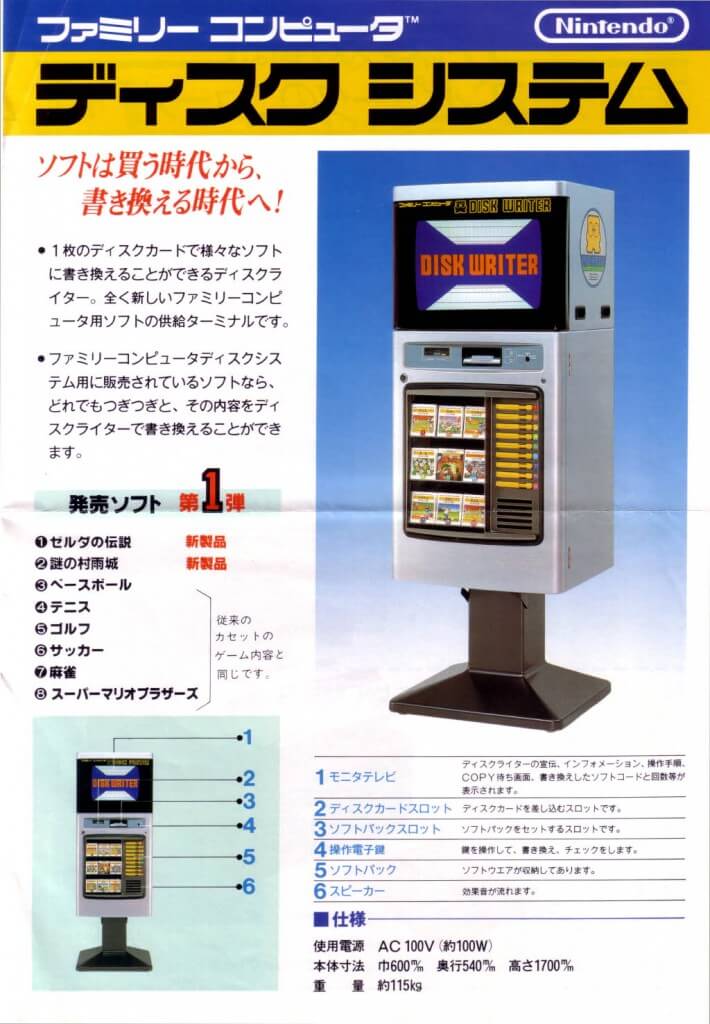
In this way, along with the new releases in Famicom Disk format that were produced every week or fortnight, which could be bought like any other cartridge, there was the possibility of recording the games and saving good money in this way. Having a single blank disc destined for re-recording already opened the doors to a new world for us, being able to buy those games we were interested in playing for 500 yen, but not enough to buy them at 5,000 or 3,000 yen.
The last units of the Famicom Disk Writer were withdrawn from Japan on September 30, 2003, a real outrage that gives us an idea of everything they represented, closing a chapter in the life of the Nintendo Famicom which lasted for more 17 years old.
But the Famicom Disk Writer service was not the only one that orbited around the Famicom and its peripheral Famicom Disk System, Nintendo put all the meat on the grill and to the joy and revelry of all those competitive players of the time, who considered themselves As well as “pros”, Nintendo created the Famicom Disk Fax, a new service offered through another electronic device located in authorized Nintendo stores, through which players in Japan could share their records and opt for prizes from Nintendo in case of being the best.
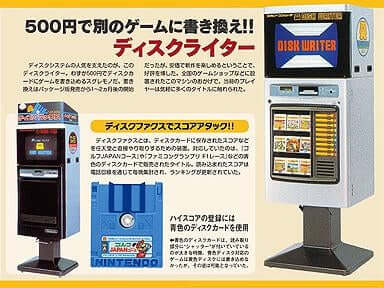
The procedure was very simple, four games were sold for this service: Golf JAPAN Course, Golf US Course, Miho Nakayama’s Tokimeki High School, Famicom Grand Prix F1 Race and Famicom Grand Prix II 3D Hot Rally. These discs differed from the rest because they were blue in color and had a shutter. Once you were at home with your console, you were addicted to the maximum to make your best score, you kept the record together with your contact information (name, street, telephone…) and you went to the authorized store with your disc, where you inserted the disk in the Famicom Disk Fax, which sent a fax to the Nintendo offices with your record and contact information. Once a year, Nintendo announced the winners in authorized stores based on a cut-off mark set by them, being able to win various prizes such as, for example, a video game from the Famicom itself.

The decline of the weekend
The Famicom Disk was one of the great peripherals of the Nintendo console, but as we all know, technological evolution is relentless, a product that made all the sense in the world in 1986 stopped having it after a few years, as we will see below:
- Loading time: One of the initial disadvantages of the Famicom Disk compared to the cartridge was that of loading times, which are non-existent on the cartridge. This immediacy was one of the hallmarks of video game consoles compared to computers, being a factor that for some made sense of the initial concept of the Famicom console.
- Capacity: In 1986, the same year and shortly after the peripheral was launched, the first 1 megabit game was published in cartridge format for the Famicom, already having a capacity greater than that of the Famicom Disk. A few months later, in July 1986, the first 2 MBit cartridge was released. This sudden increase in the memory of the cartridges was due to the cheaper semiconductors, thus overcoming the main reason for the appearance of the FDS. On the other hand, while the disks had a fixed memory, the cartridges could be expanded and adapted to the taste of the developers.
- Save games: Another of the initial advantages of the Famicom Disk over cartridges was overcome in 1987 when the first cartridge with a lithium battery was marketed to save our games, with the added advantage of being a much faster process on cartridge than writing of the FDS disk.
- Graphic and sound improvements: Another improvement brought about by cheaper semiconductors was the integration of chips dedicated to improving graphics and sound in the cartridges themselves, raising the console to another level. Something impossible to put on a disc.
- Upkeep: A large part of the Famicom’s audience were children and young people, so the strength and durability of the format was something to consider. To the evident robustness of the Famicom cartridges, another point to take into account was added, the Famicom Disk had serious problems with magnetic sources, which corrupted the recorded contents, at the same time that they were more exposed to dust and humidity.
- PC Engine SUPER CD-ROM 2: Just two years after the release of the FDS, NEC released its own peripheral… A CD player, nothing more and nothing less! This move left the image of “Nintendo’s cutting-edge technology” quite shaken. The 1988 Famicom was becoming a console for the youngest in the house (Japan).
- The sellers of the authorized stores themselves, who in those years were our most direct contact with the video game industry (for which all the wisdom of the time and our respect resided in them), complained about the minimum profit margins that entailed the Famicom Disk format along with the possibility of re-recording the games for 500 yen. Nothing like having against who sells you a product…
- Nintendo and its absolute monopoly, imposed high license fees to publish games in disc format, causing many developers to reject releasing their games in the new format.
In total, 198 commercial games and 4 non-sale games were released for the Famicom Disk System as follows:
- Year 1986: 34 titles.
- Year 1987: 69 titles.
- Year 1988: 55 titles.
- Year 1989: 20 titles.
- Year 1990: 13 titles.
- Year 1991: 6 titles.
If The Legend of Zelda was his first video game, his last video game was じゃんけんディスク城, which translated is something like Disk Castle made of stone, paper and scissors and which, by the way, was starring the Famicom Disk System mascot, Disk -kun.
Famicom models and versions
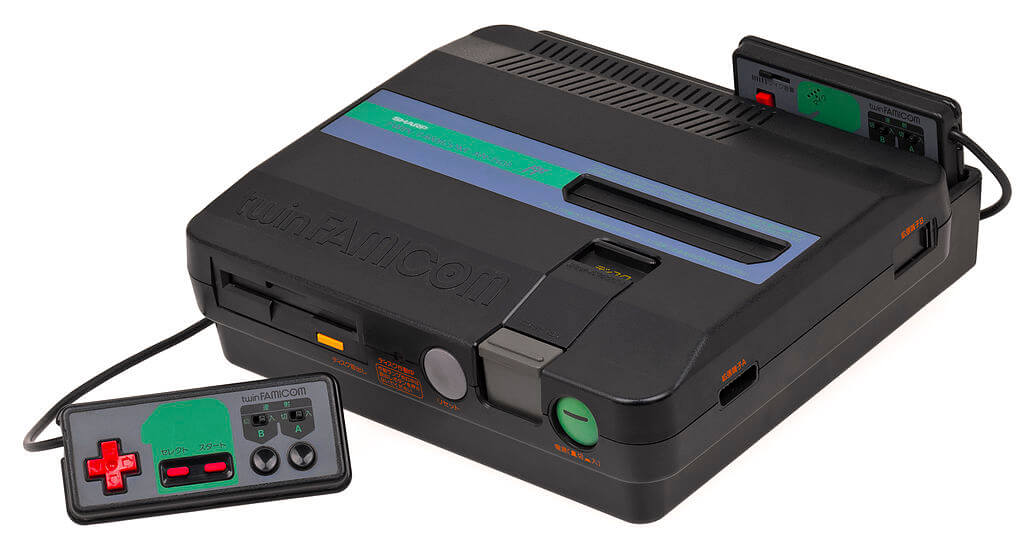
Nintendo consoles are usually so iconic that we tend to only remember the original console in our collective imagination, but nothing could be further from the truth… As we will see below, a console as popular as Nintendo’s Famicom had multiple models and versions:
- 1983 original Nintendo Family Computer, the Japanese Famicom of all life.
- 1983 My Computer TV C1/Sharp Nintendo Television: In the year of the Famicom’s launch, Sharp released a television with a built-in Famicom, boasting a higher than original picture signal with RF output.
- 1985 NES: In October 1985 the Japanese Famicom was exported to the world with a face lift to suit Westerners (Americans). The Nintendo Entertainment System, better known as the NES, arrived. With 41 million consoles sold and a catalog of more than 700 games, Nintendo once again hit the nail on the head by exporting its flagship product and business model to the entire globe.
- 1986 Famicom Station: The Famicom crossed the barrier of homes to be installed in hotel rooms, through a console with a “box” of 15 games available to play.
- 1986 Twin Famicom: Sharp obtained the license to sell the Famicom combo and its Famicom Disk System in a single console, a most interesting machine and sought after by collectors of retro consoles and video games.
- 1989 Famicom Titler: Sharp was left wanting more and 3 years later released a Famicom/video title generator with S-Video output. Useless and impressive in equal parts, as well as expensive.
- 1993 AV Famicom / NES-101: Also known as the HVC-101. A redesign of the original console heavily influenced by the American NES, which featured improved AV video output. The last Famicom AV was manufactured on September 25, 2003 with the serial number being NH11033309… 2003 gentlemen, an 8-bit console.
- CLONES: It is literally impossible to list all the Famicom/NES clone consoles. Chinese, Korean, Taiwanese, Russian… the world was filled with Famicom clones and they sold millions and millions of units. All without a license, of course.
The price of the Famicom console
How much did an original Nintendo Famicom cost? What was the price of Nintendo’s first 8-bit console? 14,800 yen, this was the price of the Famicom at its launch, but it is of little use to tell you a figure for a system launched in Japan in the 80’s, you can hardly get an idea of what that amount of money meant. For this reason, at Infoconsolas we always offer you a price comparison by year and console, so that you can perfectly understand what 14,800 yen meant in 1983 in the world of video games.
| CONSOLE | LAUNCH | PRICE | COMPANY |
| Color TV-Game 6 | 1977 | 9.800 yenes | Nintendo |
| Color TV-Game 15 | 1977 | 15.000 yenes | Nintendo |
| Color TV-Game Block Breaker | 1979 | 13.500 yenes | Nintendo |
| Computer TV Game | 1980 | 48.000 yenes | Nintendo |
| Famicom | 1983 | 14.800 yenes | Nintendo |
| SG-1000 | 1983 | 15.000 yenes | SEGA |
| Sega Mark III | 1985 | 15.000 yenes | SEGA |
| Famicom Disk System | 1986 | 15.000 yenes | Nintendo |
| Twin Famicom | 1986 | 32.000 yenes | SHARP |
| PC Engine | 1987 | 24.800 yenes | NEC |
| X1 Twin | 1987 | 99.800 yenes | NEC |
| Mega Drive | 1988 | 21.000 yenes | SEGA |
| PC-Engine Shuttle | 1989 | 18.800 yenes | NEC |
| PC Engine Core Grafx I | 1989 | 24.800 yenes | NEC |
| PC Engine Super Grafx | 1989 | 39.800 yenes | NEC |
| Super Famicom | 1990 | 25.000 yenes | Nintendo |
| Neo Geo AES | 1990 | 58,000 yenes | SNK |
| PC Engine GT | 1990 | 44.800 yenes | NEC |
| PC Engine Core Grafx II | 1991 | 19,800 yenes | NEC |
| PC Engine Duo | 1991 | 59.800 yenes | NEC |
| PC Engine LT | 1991 | 99.800 yenes | NEC |
| VICTOR WonderMega | 1992 | 79,800 yenes | Victor |
| PC Engine Duo R | 1993 | 39,800 yenes | NEC |
| Fujitsu FM TOWNS Marty | 1993 | 98.000 yenes | Fujitsu |
| Pioneer LaserActive | 1993 | 89,800 yenes | Pioneer |
| NEC LaserActive | 1993 | 89,800 yenes | NEC |
| Panasonic 3DO | 1993 | 54.800 yenes | Panasonic |
| Famicom AV | 1993 | 6.800 yenes | Nintendo |
As you have seen, the Famicom was a really cheap console compared to its contemporaries, both at the time of its launch and in later years when it had to do with systems like the PC Engine or Megadrive. Undoubtedly, the price factor was decisive for its success and market expansion and target customers.
It is worth noting the launch of the reissue of the Nintendo console in 1993 (December in Japan), the Famicom AV, which competed in the market with 32-bit consoles and CD formats, being logically aimed at a more childish or nostalgic. Even so, its manufacture lasted until 2003, so we can say that the Famicom had a full life of 20 years… Unbeatable.
Collect the first Family Computer
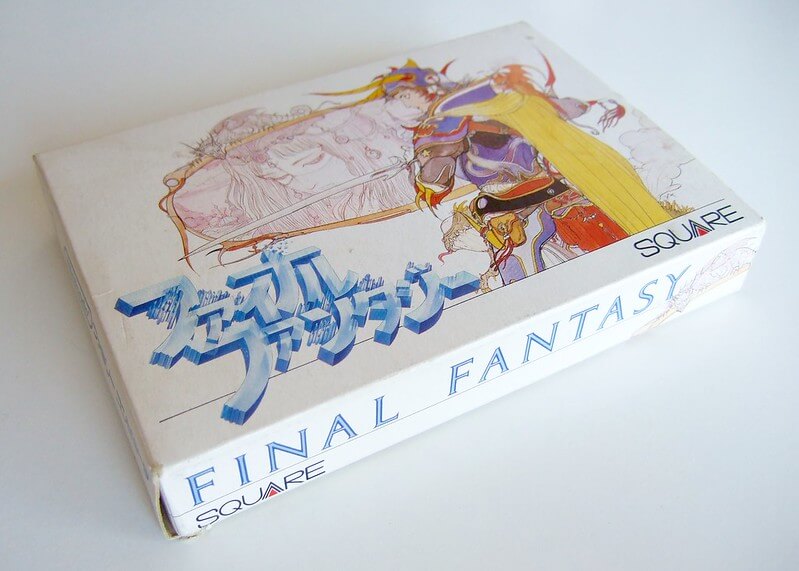
The Japanese Famicom is living history of video games, a console that meant everything in its years and which is still very present in video games today, consequently, any collection worth its salt should have an original Famicom. And an NES? Also, of course, but the catalog of the Japanese console has so many jewels that never left its borders that just for that it already justifies its purchase, in addition to its aesthetic differences and peripherals that did not reach the West such as the Famicom Disk System.
Attention!! Before buying a Famicom: Keep in mind that the original console outputs the video signal by RF and in NTSC, so if you don’t want to get involved in AV modifications, you should have an appropriate television. It may seem somewhat banal on our dates, but if you don’t have it you can end up playing Mario Bros in black and white with the sound of the Radio Maria station tuned in (true case). The controls are fixed unlike the NES, so take care of them.
The question is therefore, where do we start to collect an import console with more than 1,000 games, which the passage of time has largely negatively affected cardboard boxes, with the added problem of the language barrier And let’s not forget, many video games are completely out of date if the nostalgia factor does not act… There is really no problem:
As always in these cases, let’s forget about buying on impulse, we will have to investigate which are the best exclusive games, the ones we want for personal reasons, make a selection and list those that we are finally interested in with the price that is normally around, define very well the object of our collection: Is it just to play or to preserve? Do we want to have the most characteristic games despite not being able to play them? Do we want games or just the console? With or without a box? How many games do we consider a good representation of the Famicom catalogue? How much do we want to spend?
Only by answering questions of this type, we will be clear about how to approach a collection of a system like Nintendo’s Famicom. Our recommendation from Infoconsolas is that you set a realistic goal, a collection tailored to your budget, space and entertainment. Only in this way, having a clear objective, will you be able to plan your collection in advance and complete it without getting out of the way and phase by phase, avoiding many disappointments and frustrations.
For example, a good initial goal may be to get a console in good condition and the 10 most representative games of the system playable for a Westerner. It is a goal that you will be able to reach relatively soon, bearing in mind that you will be able to choose one or another cartridge depending on its price: We make a selection of 20 essential ones and buy only the 10 that we consider to have the best quality/price, thus saving our collection .
Once you have this research work done and your initial objective completed, you will be in a position to knowingly buy those video games that you find any given day on eBay, recognizing now if the price is cheap, normal or expensive. Don’t worry about starting small, there’s always time to grow your collection!
This really is the pleasure of collecting, if you have it clear, you will enjoy the whole process and not just the acquisition, valuing all the effort invested once you have made that video game that you have waited until you find it in good condition and at a reasonable price. .. That said, patience and good hunting!
Buy a Japanese Famicom
Where to buy a Famicom? If you don’t live in Japan, the best option is eBay, in the link below you will find a list with the original Famicom consoles available at this time and with the updated price. As we have already mentioned, acquiring a Famicom console will not be a problem if we are more interested in playing than in exhibiting, the fact of having been a tremendously successful console makes its prices very cheap for a system that is almost 40 years old (2021) .
One of the advantages of the Famicom is that being an exclusive model of Japan, the state of the consoles is usually quite good compared to the systems that we can buy in other countries. The Japanese are generally very careful with their machines, something that obviously works in our favor. Even so, be clear that we are dealing with a system from 1983, so it is normal that there is some wear on the machine or on the box.
Still in doubt? Even if it is to have the Famicom on a shelf in your room, for its current price… Yes, it’s worth it.
STOP COLLECTOR! If you’ve seen the console listing on eBay, I want to say THANK YOU. Since 2004, the objective of Infoconsolas is to contribute to preserving the history of consoles and video games through our own collection of systems and the hours of work invested in this very website.
Being an eBay partner listing, if you buy a game or console, you will be helping Infoconsolas in the preservation of video game culture, so thank you very much again!
TOP: Best Retro Family Computer Games
The Famicom is a console with a catalog of epic dimensions, so it is extremely difficult to make a selection of the best Famicom games. Consequently, for this occasion and assuming that many of you already have an NES with the best Western games, we leave you with a video of the best exclusive Famicom video games, those that never left Japan.
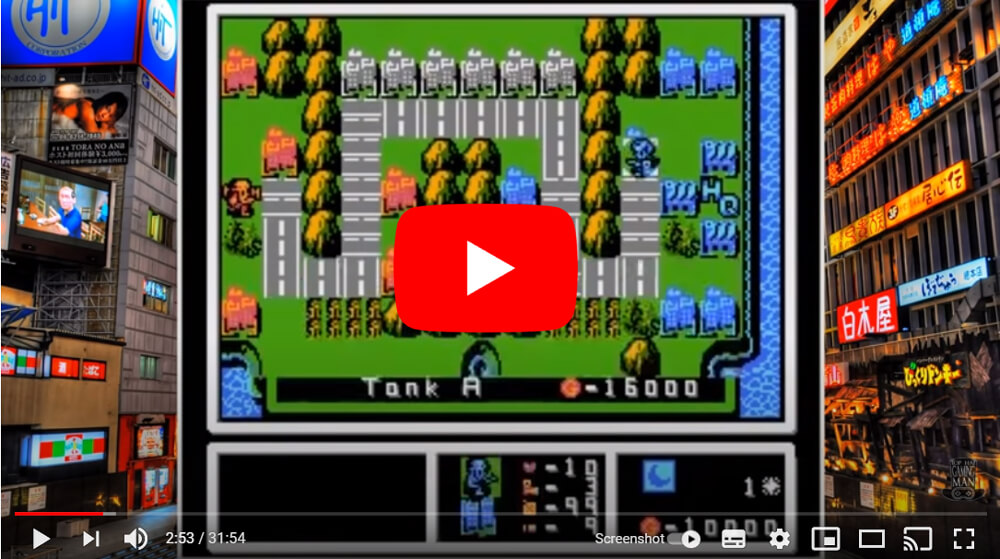
Yes, we know… There are real great games exclusive to the Famicom, in fact that Kid Dracula from 1993 is making eyes at us all… As you have seen, the Famicom has many great games in which the language barrier It is not a problem, being ideal for system lovers to combine the NES and Famicom catalog to get the most out of it, for example, RPG on NES and platforms on Famicom. Be that as it may, the Famicom has rope for a while.
FAQ Nintendo Famicom
Here you have the most frequent curiosities, questions and answers of the original Famicom Japanese retro console, little by little we will expand this section:
July 15, 1983 in Japan.
On February 21, 1986.
Yes, they correspond to the Japanese and Western versions of the same console.
19 million in Japan.
61 million.
Super Mario Bros.
14,800 yen.
3,800 yen cartridges starting.
Yes, it was cheaper than its direct competition, both consoles and microcomputers.
Donkey Kong, Donkey Kong Jr and Popeye, all video games by Miyamoto.
Very good, it sold more than 500,000 consoles in its first two months.
Masayuki Uemura.
Hiroshi Yamauchi.
60 pins.
No, they are not.
Yes it is.
Input: 100VAC 50-60Hz // Output: 10VDC 850mA //Polarity: Centre Pin Negative (+)————(o————(-)
Barrel Size: Outer Diameter 5.5mm; Inner Diameter 2.1mm.
The Famicom 14,800 yen and the Famicom Disk System 15,000 yen.
1,053 Japanese cartridges.
198 commercial discs plus 4 official ones not for sale.
Takahashi Meijin no Bōken Jima IV, on June 24, 1994 in Japan, from Hudson Soft.
The Legend of Zelda.
じゃんけんディスク城, which we could translate as: Rock Disc Castle, Paper Scissors.
It does not have voice recognition but it does differentiate the volume of the sound input, being used in some games to, for example, hit more or less hard.
Yes, in the back, they cannot be disconnected.
Yes, depending on the game. it was usually done on the B side.
Yes.
Yes, on the Disk Writer machines that Nintendo distributed throughout Japan.
2,000 yen.
500 yen, regardless of the game.
Until September 30, 2003.
896 kilobits (112 kilobytes), 64 kilobytes on each side. It did not reach what we know as 1 mega.
No, never do it since the NES is alternate and the Famicom is continuous.
Technical characteristics of the Nintendo Famicom
Below we show the technical characteristics of the Famicom:
NINTENDO FAMILY COMPUTER:
- CPU: Ricoh-manufactured 8-bit processor based on MOS Technology6502 at 1.79 MHz, with 4 tone generators (two squares, one triangle, one noise), one DAC device, and Restricted DMA Controller.
- RAM: 2 KB, with the option to use an expansion if it was present on the cartridge.
- PPU: Ricoh video processor at 5.37 MHz in its NTSC version.
- Palette: 48 colors and five grays in the base palette.
- Screen colors: 52 colors.
- Sprites on screen: 64 (without reloading in the middle of the screen).
- Sprite sizes: 8×8 or 8×16 pixels.
- Video memory: PPU connected to 32 KB of video RAM. PPU contains 2 KB internal frame/attributable RAM; 256 bytes of sprite position RAM; 28 bytes of palette RAM (allowing background color selection); 8 KB of frame pattern ROM/RAM on the cartridge.
- Resolution: 256×240 pixels.
- Conectores:
DC current input.
Ports for controllers: 2.
RF output
60 pin game cartridge slot
Extension bay
Technical characteristics of the FAMICOM DISK SYSTEM:
- Disk system main unit (HVC-022).
- 6 Type C batteries or current.
- RAM adapter (HVC-023).
- Onboard RAM is 256 kilobits for program data and 64 kilobits for sprites and backgrounds.
- Improvement in the sound of the Famicom.
External sources and links
- Technical characteristics extracted from Wikipedia
- Graphic resources:
- https://www.flickr.com/photos/bochalla/6538065139/in/photostream/
- https://commons.wikimedia.org/wiki/User:Evan-Amos

